#antwerp period
Text
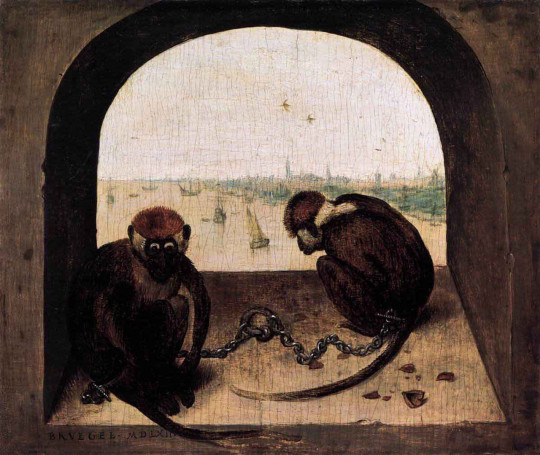
Pieter Bruegel the Elder, "Two Monkeys", 1562
#pieter bruegel the elder#art#painting#northern renaissance#antwerp period#animal painting#oil on oak wood panel#paintings#16th century#oil painting#animals in art#monkey#monkeys#16th century art
88 notes
·
View notes
Photo
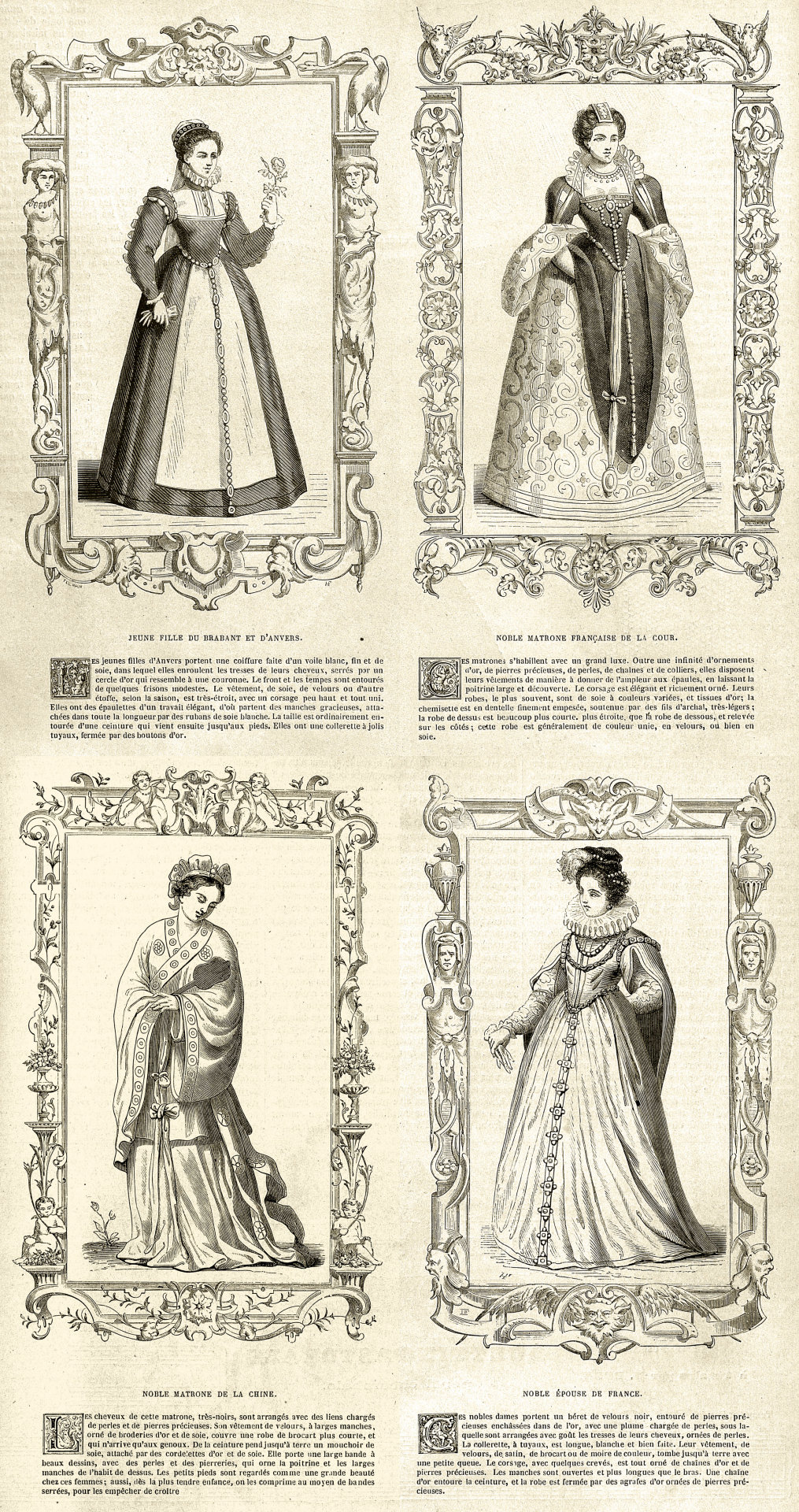
La Mode illustrée, no. 8, 24 février 1862, Paris. Costumes anciens et modernes de César Vecellio. Ville de Paris / Bibliothèque Forney
Nous avons publié l'année dernière, à pareille époque, quatre gravures empruntées au premier volume de l'intéressante collection de Vecellio*; elles ont été si bien accueillies par nos lectrices, que nous leur offrons aujourd'hui des costumes empruntés au deuxième volume de cette publication, qui est complète maintenant.
Ces costumes pourront servir de modèles de travestissements, — mais nous avons trop bonne opinion de nos lectrices, pour croire qu'elles envisageront les gravures du présent numéro uniquement à ce point de vue; celles d'entre elles qui pourront se procurer ce bel ouvrage, qui forme le plus intéressant des albums, en jugeront sur échantillon, ce qui est le plus sûr procédé pour éviter les déceptions; les autres posséderont huit gravures parfaitement exécutées, dont l'examen les aidera à apprécier, par la comparaison, le mérite des modernes gravures sur bois.
Costumes anciens et modernes, de César Vecellio (le Titien), 2 volumes, chez Firmin Didot, rue Jacob, 56.
—
Ancient and modern costumes by César Vecellio
We published last year, at this time, four engravings taken from the first volume of the interesting collection of Vecellio; they were so well received by our readers that today we are offering them costumes borrowed from the second volume of this publication, which is now complete.
These costumes could serve as models — but we have too good an opinion of our female readers to believe that they will consider the engravings in the present issue solely from this point of view; those among them who can obtain this fine work, which forms the most interesting of albums, will judge of it by sample, which is the surest method of avoiding disappointment; the others will possess eight perfectly executed engravings, the examination of which will help them to appreciate, by comparison, the merit of modern wood-engravings.
Ancient and modern costumes, by César Vecellio (Titian), 2 volumes, at Firmin Didot, rue Jacob, 56.
#La Mode illustrée#19th century#1800s#1860s#1862#periodical#fashion#fashion plate#retouch#description#Forney#Vecellio#publication#history#masquerade#china#Antwerp#court#noble#France
60 notes
·
View notes
Note
🌅⚔️🦑💀 for ockham??👀
🌅 — Do they miss the Surface? What was their life like up there?
Everything pales in comparison to that extended viric dream, so there are far better things to miss. But if that were for some reason no longer in hishertheir memory and completely out of the picture then heshethey would miss the comfort of hishertheir old life (before being pressganged, at least). That life wasn't easy or particularly pleasant, but it was an honest day's work, and familiar. But the Surface has changed over a century. Maybe it was a Dream, maybe a memory, but Ockham's stood on familiar streets, on rain-reflected cobblestones watching the steam-powered machines pass. The port is familiar, but not the name of the place it belongs to. Returning would be impossible now anyway. And for what? Anyone from that life would've been long dead.
⚔️ — Do they have a particular fighting style/signature weapon?
Ockham tends to carry a couple of knives (and occasionally a pistol, should the situation call for it--they've become much easier to wield and more accurate since herhertheir time on the surface) and hishertheir fighting strategy generally consists of "hit as hard and fast as possible to end the fight as quickly as you can by any means necessary, before it can turn south". It's a strategy that's kept himherthem alive thus far, and no reason to fix what isn't broken.
🦑 — Would they kiss a Rubbery Man?
I'm absolutely positive that Ockham has, and it's contributed to getting himherthem sent to the Tomb Colonies at some point. Ockham tends to get on with the Rubbery Men, both of them feeling slightly out of place in London.
💀 — What's their relationship with the Boatman like?
Ockham likes the Boatman. They've only met a small handful of times. The Boatman doesn't seem particularly demanding, doesn't speak much, and always willing to play a game or two. And when he does speak, language doesn't seem to be an issue, making him one of the few conversation partners Ockham has in hishertheir native tongue.
#ockham#i don't like to think too hard about ockham's past because historically it's such a headache#antwerp technically wasn't much of a trade city in the time period i'd locked myself into#and i think it went from austrian to french control in ockham's lifetime#ok no the headache is starting#it's my oc and i can do what i want forever#performing shapeling arts on early 18th century/late 19th century europe#just like fbg does
5 notes
·
View notes
Text
Prolonged love - Joseph Liebgott x Fem!Reader

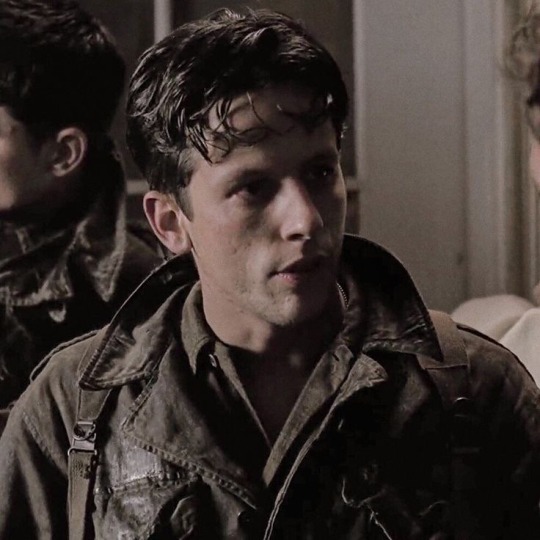
Summary: Sometimes the best things in life take a long time, and sometimes life throws you for a loop. It sure threw (Y/n) for a loop when grabbing German POWs in Hagenau turns into her having to babysit a young Dutch girl.
Tw: Swearing, death, reader being trilingual, mentions of war, mentions of concentration camps, mentions of abuse, killing, slightly dirty? not full on smut, reader is female, slight misogyny due to the time period, she/her pronouns
Word count: 6.5k
I do not own Band of Brothers, nor do I own any of the characters. I am not intending to be disrespectful towards any of the people on this show
The Dutch name is pronounced like (Tina-ka) Tineke, and the nickname Tine is pronounced as (Teeny)

I was born in Chicago. My mother was born in Groningen, Netherlands, and my father in Antwerp, Belgium. I was the oldest child, and after me, my parents had five others. Despite having six kids, we were all taught Dutch and German from a young age. The sole reason I was accepted into the military was because of me being trilingual, I’ll forever be grateful to my parents for teaching me their languages.
February 9, 1945
Easy Company was on its way to France. We were stationed in Haguenau, which had been taken by the Allies in December. Honestly speaking, I didn’t really know what to expect when we got there. I was sitting in the back of a truck, squished between Babe and Liebgott. Joe had become a close friend way back in Toccoa when he’d fallen running up Currahee, and I stopped and helped him up. We both had our 48-hour weekend passes revoked, but we made the most of it that weekend together. After that, we’d spend our weekend passes together and hang out.
I was leaning against Joe as I’d been almost the whole ride, his arm slung around my shoulders as I read a book that I had found when we invaded Foy. It seemed the Krauts enjoyed good literature as I was reading For Whom the Bell Tolls in German. I was a translator for Easy Company, being able to speak English, German and Dutch, I was a heavy asset to the team. It was a beautifully told story about the Civil War that had some romance aspects while also being brutal. I finished the book twice, and now I was reading it a third time.
“Jesus doll, I think I’ve seen you read that damn book about forty times now. How good can it be?” Joe said when he noticed my attention had strayed.
“Oh it’s a beautifully told story, Joe. Although, I don’t think you could read anything that didn’t have pictures.” I replied jokingly to him, looking up at him from where I was leaning against him. I could hear Babe and Malarkey laughing, and a young soldier, Jackson watching intently.
“How can you read that, (L/n)?” A quiet voice asked in front of me. It’d been from Jackson. He lied on his documents so that made him 20 right now while I, at 23, was considered young.
“I can speak and read German. Although my mother is a Dutch immigrant, my father was a Belgium immigrant.” I spoke honestly. Picking up languages was a bit of a gift for me. I’d always been good at remembering and learning languages, probably since I was taught three languages at once from a young age.
“(Y/n)! I’ve read that book! It’s so beautifully written.” A new voice spoke from the opening in the back of the truck, I quickly jolted from Joe’s shoulder, as he groaned from lack of contact, to see who the familiar voice belonged to.
“David Webster? Where the hell have you been?” I interrogated, while simultaneously giving him a toothy smile. He blushed slightly while asking Jackson for a hand to get up on the truck and suddenly Joe spoke up sharply,
“The hospital. Must’ve liked that hospital Webster, cause uh, we left Holland four months ago.” After saying that he gave Web a dismissive look while tightening his hold on my shoulders. Suddenly, I felt very awkward, and slightly bad for Web - the war was tough and it was understandable to be afraid, it just wasn’t fair that some men snuck out only to get killed or injured more severely than the first time. They started going back and forth, jabbing at Webster passively, although it didn’t seem to be because they didn’t like him, they were just tired and upset. I gave Web a smile before getting off the truck, following Joe close behind.
“Y’know, you didn’t have to be so mean to Web.” I said calmly, making sure to not seem mad at Joe as to not have him get defensive.
“I guess, but it’s bullshit that we had men come back just to get killed.” He said quickly. When he said that, I saw Lieutenant Lipton sluggishly walking towards a building. The poor man had a bad case of Pneumonia, so I ran over and put his arm under my shoulders to help him. As I did that, explosions rang over our head and fell a little farther than we were. He gave me a smile and I helped him into the building he was walking towards. It was pretty on the inside, Luz and Captain Speirs were in the room along with Webster walking in.
“Hey look who it is. Nice digs, huh, Lip? (Y/n)?” Luz said to me and Lipton as I helped Lipton situate himself on the couch.
“Yeah.” Lipton called back, unenthusiastically and coughed slightly after.
George came over with a blanket and put it on Lipton. He had a lit cigarette in his mouth, so I took it out and took a long drag from it.
“Hey what gives (Y/n). Just ‘cause you’re a pretty dame with a nice rack doesn’t mean you can steal my cigs.” He said while laughing, only partly joking. I gave him a look and replied,
“You’re just mad, this is all you get to see of my ‘nice’ rack.”
He laughed and replied with a ‘you bet’. As he said that, a new voice spoke up, mock confident.
“Ahem. Is this the company CP for Easy?” He asked, looking at me and Luz weirdly before I went to get Lip a cup of hot coffee.
From the kitchen, I could vaguely hear that he called himself Lieutenant Jones and that he was asking for Captain Speirs. I came out with a coffee for Lipton as Speirs was drilling him about going to the back to sack out and rest. I noticed Jones had stood up when Speirs walked in.
“Christ Captain, give him a break. He’s got Pneumonia!” I told Speirs as I handed Lipton his coffee and gave him a squeeze on his shoulder. Lipton thanked me with a small smile as the new guy looked at me with an expression I couldn’t decipher.
“Hello to you Ms. (L/n). If he doesn’t rest up though, that Pneumonia won’t go away.” He said pointedly at Lipton.
“I’m sorry, are you a field nurse? I didn’t think they let field nurses come this close to action.” Jones asked me, even though he wasn’t asking with any malicious intent, and it was all curiosity, I still got upset.
“Why d’ya think I’m a field nurse? I’m literally in uniform.” I deadpanned at him while giving him a little attitude for automatically assuming I’d be a field nurse just because I was a woman.
“Oh. I’m sorry, truly I was just curious. I didn't mean any offense, I just didn’t know they let women become paratroopers.” He said quickly, face turning slightly red.
“They don’t. (Y/n) here has some insane stamina, and she’s a helluva shot!” Webster spoke up for me, and I threw him a smile.
“Oh gee, Shifty’s got a better shot than I’d ever dream of having.” I replied, giving credit to Shifty, as he did have a better shot and he was just the sweetest man alive. At that, Winters walked in and told us he’d need fifteen of us on a patrol tonight to capture prisoners. When he said he’d need a translator, I instantly knew it’d be me or Joe as we were the only two in Second Platoon who could speak German. Webster could as well, but we didn’t know which Platoon he’d be in.
After Nixon and Winters left, Speirs began talking to Lipton about who should lead, and who he could take for the patrol. During this, Jones asked to be on the patrol, which Speirs answered quickly and easily with a no, that he hadn’t any experience.
“Lipton, how many prisoners do you think there’ll be?” Speirs asked the man in question.
“Honestly, sir, I’m not quite sure, anywhere between three to forty it seems.” He said in reply.
“(L/n).” Speirs called for me as I was sitting in a chair reading.
“Ya want me to be a translator, that it?” I asked, knowing that’s what he was about to ask me.
“Yes ma’am.”
“Alright.”
When Webster and Lieutenant Jones left for OP two, I decided to get going as well. I knew Liebgott would be there so that was a good enough reason for me.
“Web, I’m comin’ with. Joe’s probably there right now.” I said to David, although slightly talking to Jones as well, to let him know I’d be going to.
“Yeah, no problem. Say when you’re finished with that book, d’ya mind if I reread it?” He asked me as all three of us walked down the street.
“Awh hell Web, I’ve read this thing three times now, you can go ahead and read it now.” I said while throwing him the book, silently noting how quiet Lieutenant Jones was behind us. The two men were running around crouching behind a little garden wall as I stood up, not seeing why they were doing that. When I heard the door open, Sergeant Kiehn came out, greeting me and Web and telling us where OP two was at. Before anymore words could get exchanged, bombs and mortars started raining down on us and we started running and ducking to take cover. We sat against the wall of a building before a man shouted out that it was all clear. After that, we quickly got to the building where OP two was located. Once inside, I immediately went upstairs and sat down on Joe’s bunk and plopped my stuff down.
“Hey doll, where’d you run off to?” Joe asked while wrapping his arms around me as a way to annoy me.
“Went to help Lip, where’d you go?” I asked while laughing at him.
“Came here.” He replied while digging his face into my stomach and faking sleep. Web and Lieutenant Jones came up not too long after I had, and when Jones saw me and Liebgott he immediately stiffened and gave me and Joe a weird look.
“This spot taken?” Webster asked.
“Nah it’s all yours.” Joe said to him while turning his face away from my stomach, my hands went down to card through his hair and he took notice of Jones’ look.
“Fuck are you staring at?” Joe asked him while sitting up and giving him his own glare.
“I’m sorry?” The Lieutenant asked, offended.
“You got a starin’ problem? Why you lookin’ at me and (Y/n) like that?” He challenged him.
“Alright, alright. Quit fighting, we’ve got news.” Webster said, breaking up the fight.
“Dummer, zimperlicher Junge, der dich so ansieht. (Stupid, prissy boy, lookin at you like that)” Joe mumbled to me in German, only loud enough for only me to hear.
“Er ist einfach sauer, weil du mich berührst und nicht er. (He's just mad because you're touching me and not him)” I said back laughing.
Me and Joe got up to go talk to a bunch of men in the corner laughing and smoking, while Webster and Jones went to talk to Malark. When Joe heard them talk about the patrol he pulled Web aside and I went and sat next to Babe to listen to what he was going to say.
“What do you know about this patrol thing?” Joe asked Web quietly.
“Uh, nothing.” Web said while nodding his head.
“Oh, come on, Web. You gotta know something.” Ramirez interrogated.
“I don’t” He replied adamantly
` “Bullshit.”
Web and everyone went back and forth and soon more people sat down to listen. I knew Web wouldn’t give anything up, so I decided to. My head was starting to hurt and I wanted to lay down before the patrol knowing I’d be on it at 0100.
“Speirs is picking fifteen men, Jonesy boy wants to be one of ‘em.” I said while yawning. Joe looked down at me and said,
“I say let the kid go, he could use the experience.” He smiled then Ramirez perked up,
“And I bet they could find fourteen other replacements to help him out.” while smirking.
“Nope.” I said, popping the p. “Babe, McClung, Ramirez and I are going out there.” I said dismissively.
“(Y/n)!” Web hissed at me.
“What?” I asked, confused. Then proceeded with,
“Pssh, I’ll just say it was you who said it, Joe and Babe’ll back me up, won’t you boys.” I asked, smiling up at Joe then at Babe.
“Course we will, doll.” Joe replied and Babe grunted. Webster deadpanned me and sat down when Malarkey started telling us about the patrol.
When the phone rang, and the PX supplies came in, I was ecstatic. New shoes and a shower? Felt like late Christmas. On our way out, the Krauts started to bomb us. We ran down the stairs and I threw myself under a table with Joe. When we had made it outside, we heard there was a casualty, Bill Kiehn. He was a Toccoa man. It was upsetting and it was unfair that he’d gotten through Bastogne only to die like this. I hadn’t known him too well, but the fact that I’d been talking to him 30 minutes prior made me feel like throwing up. Instead of staying to watch, me and the rest of the second platoon went over to the showers to pick up our new ODs.
Arriving at the showers, we went to go pick up our new ODs, and anything else they’d dropped for us. Nixon was standing by the depot and was holding a box with my name on it. Being the only woman paratrooper here meant I’d need a different size uniform and boots. I thanked Nixon and grabbed the box, opening it. Inside there was a uniform my size, boots, and women’s sanitary needs, a new bra set, and a few new pairs of panties.
“Well ain’t you a lucky gal, getting new undergarments while we’re stuck with the same briefs.” A voice came from behind me. Getting ready to yell at whoever was looking over my shoulder, I turned and realized it was Joe.
“Aww, poor baby has to wear the same briefs.” I replied, feigning upset and then laughing when I saw his disgruntled expression.
Before I could run off to take a much needed shower, Malarkey called for us to let us know who’d be going on the patrol.
Heffron, McClung, Ramirez, me, Liebgott, Grant, Wynn, Jackson, Shifty and Webster. When we heard how many second platoon men were going, you could practically feel the rage flowing from us.
We’d all been pissed, wanting to complain but knowing it’d do us no good. Malarkey went off towards the showers and told us to as well. There were men standing at the entrance, undressing and some coming out wet. I didn’t want to undress, even if it was only down to my bra and panties. I’d been behind Joe when I took my first few layers of my tops off. Down to my black bra and army-issued pants was when Webster came up to talk to Joe, effectively, scaring the shit out of me.
“Jesus, Web, you came outta nowhere.” I said, holding my hand to my chest to calm down.
“Oops, sorry (Y/n).” He said while rubbing the back of his neck nervously. I’d noticed his face had turned a bright shade of red, but I thought it was because he was embarrassed that he’d scared me. A hand shot out to grab my arm and turn me around when I noticed it was Joe.
“What’s the matter?” I asked curiously.
“Do you not see everyone lookin’ at you like they’re starving men looking at their last meal?” He asked bewildered. Suddenly, I became hyper aware of most of the men's eyes on me, waiting for me to finish undressing. Before I could respond Joe spoke up again.
“Nevermind that, just finish and we can go in together.” Quickly I went to undo my belt, and I realized Joe was already down to his briefs, waiting on me. I felt bad to make him wait, but he didn’t have to if he didn’t want to. I took this time to really look at Joe. Sure he was cute, and I’d definitely thought about him like this before, but would he really want me? I tried not to let my hopes get up, and as I slipped my pants down my legs, I forced myself to look away from his bare chest.
Having a hot shower was probably the best thing I’d had in a long time. Quickly scrubbing my body and hair down and then rinsing off, I stepped outside in a towel and grabbed my new uniform, and new undergarments.
Joe had finished showering, so I grabbed him by the arm and dragged him to a random building to change, and do my hair. When we got in, there was nobody there, probably all in the showers, so I took Joe to the first mirror I found in a bedroom and made him sit down. He had no obligations and I told him I’d be back after changing. Once I finished, I brought out my old undergarments and towel and hung them out to dry.
There was a vanity on the opposite side of a bed, with a little cushion seat, and some old, dusty hair products. I quickly got to work using them and braiding up my hair.
“Why’d you pull me away doll? Want me that bad huh?” He questioned while smirking at me and drawing a cigarette from his front pocket.
“Yeah, you wish. I wanted someone to talk to.” I joked back before replying honestly and looking at him through the mirror. I finished doing my last braid as Joe was telling me about one of his comics he found that he enjoyed. Standing up, I walked over to stand in front of him, looking down on him as he was sitting on the bed. He stopped talking and we made eye contact. He looked as handsome as ever sitting in his new ODs, with a fresh shower.
“Well don’t you look handsome in your new uniform with your hair combed.” I said to him in a sweet voice running my hands through his wet hair. His eyes darkened as his hands went to hold onto my hips.
“Jesus, (Y/n). We’ve been through hell and back and you’re still the most gorgeous woman I’d ever seen.” He said confidently. I could feel my face getting hot, he’d said things like this before, but this time, it felt different. Stronger almost.
“Oh, Joe. You’re the most handsome man I’ve ever met.” I whispered to him, and he looked up at my lips, silently asking me. I slowly closed my eyes and let my hands fall from his hair down to his face, I slowly leaned down as he looked up and closed my eyes. As our lips were less than a centimeter apart, someone awkwardly coughed.
We sprung away from each other, embarrassed that we got caught. Looking at who it was, some random replacement apologized and said he left something in here and it was his room.
When he left, I started laughing and grabbed Joe by the arm to pull him up.
“Come on, I bet everyone is wondering where we went.”
“Goddammit Johnny, you’re breaking my heart.” Luz said.
“Come on, George, just give me, I don’t know, ten, fifteen bars?” Martin pressured him
“Juicy fruit, happy?”
Johnny and Cobb had been pestering George to give them Hershey bars. I knew there wasn’t enough, and that it wasn’t fair so I just stayed quiet the whole time. Cobb began badgering George again and when George went to defend himself, a whole group of men walked in.
“Whoa, Hershey bars!” Joe exclaimed, coming up behind me to rest his hands on my shoulders from where I was sitting in front of the table of candy and treats.
“Jesus Christ.” Poor George just couldn’t catch a break.
“Wait your turn, Liebgott.” Cobb said, pissing me off. I never really liked Cobb and he didn’t like me.
“Yeah, who they for?” Liebgott asked George.
“Not you, Lieb.”
“Oh come on George, one bar!” Joe pestered, wanting to get that bar.
“Y’know who they’re for? People who don’t interrogate me. Here, (Y/n), have a bar!” George replied while looking Joe in the eye.
“Oh George! Thank you!” I exclaimed excitedly. I hadn’t known the last time I’d gotten chocolate.
“Christ, you’re only giving it to her because she’s a woman and you wanna get on her good side in case the opportunity arises to fuck her!” Cobb said angrily as I turned around, glaring, ready to hit him.
“That sounds more like something you’d do, knowing you couldn’t get a woman to sleep with you willingly if your life depended on it!” I yelled back at him which caused him to call me a slur of colorful words. After that, Joe yelled at him and I ignored him.
“Hey big mouth! Give Lieb a Hershey bar, huh?” Perconte asked.
When I heard his voice, I jumped up, running up to him to give him a hug.
“Perco! Your back!” I exclaimed as he hugged me back.
“You gotta be shittin’ me! Look who it is!” George laughed and said.
“How ya feeling?” Joe then asked him, smiling.
“As long as you keep your hands off my ass, I’ll be fine.” Perconte replied, laughing.
“Have a Hershey’s!” Luz threw one at Perconte.
“Hey he gets a fuckin Hershey bar?” Joe asked, offended as I came to sit down next to him, opening up my Hershey’s.
“Ask ya girlfriend to french ya when she’s done eating it.” George joked as I took a bite into my bar and broke it in half.
“I’ll do you one better, Joe.” I said after I swallowed and handed him the half I didn’t bite into. He took it with thanks.
“That’s not one better, he’d rather you kiss him (L/n)!” Luz said while laughing right after. Joe pushed him backwards while also laughing
At 1700, there was a briefing about the house we’d be going into. I was next to Shifty, talking with him. Every now and again me and Joe would make eye contact, until the other looked away. Winters, and Martin walked in which caused Joe to look away first. Winters explained Johnny would be going in Malarkey's place, and that made everyone slightly more comfortable. I was on Johnny’s team, along with Webster. I walked out and Liebgott was waiting for me, he left with me and as we passed Speirs, he told Joe he didn’t have to go on the patrol.
We’d been all stationed in the basement for now before the patrol. Having to eat slop and we couldn’t have our helmets. I sat with Shifty as I ate.
“Youse gonna be out there with a gun?” Shifty asked me in a sweet voice, I knew what he was talking about. He was asking if I’d be helping shoot.
“Nah, well obviously I’ll have a gun, but I’m mainly a translator.” I smiled at him and he smiled back.
“I don’ understand why they never let you shoot with me. You’re a helluva sniper.” Shifty told me, making me giggle at him.
“Oh Shift, you know how to make a woman feel good about herself.” I replied, happy that I got to talk to him before the patrol. He always knew how to make someone happy, even during nerve-wracking times.
At 0100, we were getting into those rubber boats, and setting sail on a short trip across the river. Before the fourth boat could even get far, it flipped and we were down three men. I wasn’t too nervous, knowing that I’d been through worse. When we got to the other side, Martin had someone cut the fence and me and Web, being translators, meant that we had to be up front in case we found any Germans.
So far, we’d gotten up to the steps of the house we’d need to get prisoners from. Johnny had shot into the window, and Jackson went up to throw his grenade, except, instead of waiting for it to finish detonating, Jackson didn’t stop and immediately went into the house, getting hit straight in the face with his grenade. As we ran in, me and Web were yelling at the men in German. We started to split the three men up when I heard a small cry in the corner of the room. I stopped to turn to go towards the sound.
“(L/n)! What are you doing?” Johnny yelled at me.
“Sir! There’s a child!” I shouted, confused. When I got down eye level with the little girl, I noticed she was only in a thin, white nightgown, with no shoes. She looked malnourished, hurt and mostly scared.
“Alsjeblieft! Alsjeblieft! (Please! Please!)” The little girl cried in Dutch, shrinking away from me when I went to get her.
“Het is goed schat! Rustig maar, ik ben hier om te helpen! (Its okay dear! Relax, I'm here to help!)” I replied to her in Dutch. What had a little Dutch girl been doing here? I didn’t have time to continue to calm the little girl before Johnny started yelling about getting on the boats and leaving.
“Klein meisje, ik ga je ophalen. (Little girl, I'm going to pick you up.)” I warned her before grabbing her bridal style and running with her out of the house and covering her eyes to make sure she didn’t see what was happening around her with Jackson. Pushing everyone into the boats, the girl I was holding onto kept crying and crying. The poor little girl couldn’t have been more than four years old.
“Het is goed schat. Het is goed schat. (It’s alright baby. It’s alright baby.)” I kept repeating to the small frightened girl. When Webster jumped into the boat behind me, we started going back to our side. He had his head ducked, as the Krauts kept shooting at the back boat. He had his arms around me when he realized I was shielding a child.
“(Y/n)! What the hell? Why do you have a child?” He yelled out over the gun fire.
“I don’t know! She was in the corner, she’s Dutch!” I replied, still confused as to how she got here and why she wasn’t in the Netherlands. We all ran downstairs, I was still holding onto the little girl, she had come from the Germans territory so I had to stay with her by the other prisoners. Nobody had come up to me about the girl yet so I took this as a time to try to get information so she wasn’t bombarded when adrenaline wore off.
“Wat is je naam? (What’s your name?)” I asked her calmly. She looked up at me with teary dark blue eyes. “Tineke.” She responded in a quiet voice. I was sitting on the floor and I held her so she was only facing me. I could feel someone watching me, but for now I didn’t care.
“Mooie naam! De mijne is (Y/n)! (Beautiful name! Mine is (Y/n)!)” I replied while smiling at her and gently carding my hand through her dark brown strands. Her skin was deathly pale and it was obvious she hadn’t drank or eaten anything in a long time. I gave her my canteen and she took it wearily. She wouldn’t drink it because she was scared of what could be in it. I took it back and took a small sip and gave it back. When she noticed I was okay, she started drinking out of it rapidly.
When she finished drinking, I asked her more questions.
“Spreek je Engels? (Can you speak English?)” I asked her.
“Little bit.” She replied hesitantly.
“Very good, mijn liefje! (My love!)” She seemed to smile a little at the name I’d given her.
“Where is your mommy?” I asked slowly. She started to get upset at the mention of her mother but she replied anyway.
“She die. The Duits kill her. I am Joods. They take her and kill my mammie in de camps for Jodens. Then they keep me. (The Germans kill her. I am Jewish. My mommy. Camps for Jews.)” She told me in a somber tone. When she couldn’t think of the right word, she’d just say it in Dutch. I thought about bringing her to Joe later knowing he was Jewish, she might feel comfortable with him.
“You’re safe now, liefje.” I told her while bringing her close to my chest. She ended up falling asleep not even ten minutes later. It gave me time to think about what she had said. She never mentioned a last name which made me believe she didn’t know it. The camp she was talking about was also weird. What did she mean by a camp for Jewish people?
Jackson had died. That boy who’d just turned twenty, had died. He had his whole life ahead and he died in a stupid war. I hadn’t even known him too well, but he just died in front of me, in front of everyone. I was thankful Tineke was asleep as she’d already seen enough.
A day had passed since the patrol. The Germans were taken away and Tineke wouldn’t talk to anyone except me, and occasionally Joe. When Winters had found out about her, he had to ask her questions. I had come with because she couldn’t speak English very well and she refused to go anywhere if I wasn’t with her. The poor girl had been traumatized and it seemed like she’d been like that for a while.
While asking her questions, we found out her family was Jewish, and when the Germans found out, they took her and her family out of their homes to be sent to a camp. She didn’t know much, just that her mother and her got away and when they were found by the two Germans, her mother tried to fight against them resulting in her getting shot. Tineke was then taken as a hostage.
Doc Roe came in to see how she was and it turned out she had been malnourished, and if I hadn’t found her when I did she would’ve been dead. Later that day I took her to the building where the second platoon was located to introduce her.
I walked in and held onto Tine and went upstairs.
“Guys, this is Tineke. She was found in the house with the other POWs and she’s Dutch. She can speak some English, but don’t bombard her.” I spoke when I went upstairs and saw everyone. They all looked at us, and one by one I walked around with her and had her say hi to everyone. When I got to the last person, Joe, I sat down on the bunk with him and had her greet him.
“Tine, why don’t you tell Joe what you are.” I reminded her. I had told her to tell him she was Jewish before we went upstairs.
“Jewish.” Was all she said, nervous and not knowing too much English, she turned her face away into my chest. I rubbed my hand down her knotted, dirty hair realizing she needed a bath.
“Ain’t that cool! I’m Jewish too!” Joe responded in a sweet voice, smiling down at her when she slightly turned her head towards him. Before any more words could get exchanged, Webster came in to break the news that we were to go on another patrol that night and there would be another meeting at 1800. It was currently 1530 so I decided to bring Tineke down to the kitchen sink where I could give her a makeshift bath. I remembered how my mom would do that for me and my siblings when we were little and there were no baths in any of the houses.
I grabbed some soap and put it in her hair while I’d tell her stories to pass the time.
“A long time ago, there were two moons. It was said one of them, named houden got too close to the sun, and out came thousands of dragons.” I told her a story my mother used to tell me all the time.
“Houden? To hold?” She asked as I began rinsing out her hair.
“That’s right. That’s how dragons were born.” I told her. As I finished saying that, another voice piped up from behind me.
“I didn’t know dragons were born from the moon.” Joe came up behind me and waved at Tineke, who brought her hand up slightly.
“That’s because I never told you that.” I said while smiling up at him. He moved to have his arms around my waist and laid his head on my shoulder. I finished rinsing Tine off then I grabbed a towel and wrapped her in it. Nixon had got clothes small enough to fit her from one of his sources. It was a small, black dress with a dark brown fluffy shawl. She also had stockings and tiny boots. When I finished dressing her, I braided up her hair and put on a hat.
At 1800 we all went down to the basement to await Winter’s meeting he called.
“Whatcha lookin’ at Webster.” A drunk Cobb said. I put one of my hands on Web’s shoulder, holding Tineke to my chest as she slept on me, and he turned to give me a smile.
“That’s what I thought, college boy.” Cobb said while swaying lightly on his feet. I gave Cobb a glare and squeezed the hand I had on Web’s shoulder.
“Are you drunk, trooper?” Lieutenant Jones asked him, angrily.
“Leave me alone.” Cobb replied, looking away.
“Answer the question.” Jones said firmly.
“Yes, sir, I am drunk, sir.” Cobb said sassily before adding, “Drunk, and sick and tired of fucking patrols. Taking orders-”
“Hey Cobb, shut up. It’s boring, okay.” Martin cut him off before he could finish what he was saying.
“Taking his side, Johnny?” “Yeah, I am.”
After that shit show I went and sat by Joe, wanting to make sure I wouldn’t be in Cobb’s line of fire in case he decided to throw something.
Winters came in to not only tell us that we didn’t have to go on that patrol, but that we’d also be off the line tomorrow. After he left, everyone started talking, which woke up Tine, who had no idea what was going on, but was happy because everyone else was.
When I went upstairs, Winters was waiting for me.
“Hey, (Y/n).” He said, a bittersweet tone to his voice.
“Hello, sir. Anything I can help you with?” I asked, slightly nervous that he had waited for me.
“It turns out, we found one of Tineke’s family members. Her aunt and uncle. They’re set to come tonight.” He said quietly.
“Oh. Well that’s great!” I smiled slightly, feeling my heart get heavy at the fact that the young girl would be leaving.
“Tine, you hear that? Your aunt and uncle are coming to pick you up.” I told her, looking down at her. She perked up, looking between me and Winters and then she smiled. She smiled bigger than I’d ever seen her smile.
When her aunt and uncle arrived at 2100, Tineke ran up to them and they picked her up. They repeatedly thanked me and Winters and before they left, I gave Tineke a hug and kiss and turned around to walk away. As I did that, I noticed Joe was standing there waiting for me, smiling sweetly at me. We walked away, arm in arm to go back to the house together. The next day, we’d all been sent to the trucks to move to our new location. I was sitting next to Joe, my head on his shoulder as I slept.
We had made it to Germany. The Krauts surrendered and Hitler shot himself. We were finally able to stay in an actual house, with actual baths and actual beds. To us, life couldn’t get any better.
Me and Joe had been sharing a house with Perco and Luz. Frank and George went out to get eggs from a farmhouse a few blocks down so right now it was just me and Joe.
“You excited, doll?” He asked me from the table. I put down one of the wet dishes I was washing, and replied,
“For what Lieb?” “We got through the hard part!” Oh. I hadn’t really thought about that yet.
“Well, yeah, I guess. I’m just scared that I’ll have to go to the Pacific if this war finishes soon.” I replied genuinely.
“Oh don’t worry about that right now.” He said while standing up and coming behind me. I put down the last dish and pulled off the wet, yellow gloves I had on to wash the dishes in.
“Y’know, Perco and Luz just left.”
“I know Liebgott, I’ve got eyes.” I replied, smiling up at him while turning around to face him. He put his hands on the sink behind me and smiled down on me.
“Well if your eyes are any good, then you’ll be able to see how much of a hold ya got on me.” He spoke before closing the distance between us and closing the gap.
I immediately closed my eyes and kissed him back. We slowly pulled apart, and without another word he slammed his mouth into mine. This time, he was much more passionate. His hands wandered down to my waist, and mine went up to his neck and hair. I gasped as he bit my bottom lip, and he snuck his tongue into my mouth. I kissed him back with as much fervor as I could, slightly pulling on his hair without realizing. He moaned into my mouth and the vibrations caused heat to pool in my stomach.
His hands started to roam down my body, causing me to moan as well. He pulled me flush against him and then pulled me up the stairs into one of the rooms I was occupying. I gently sat down on the bed and his fingers went to my uniform top, unbuttoning my shirt.
Perconte and Luz were walking down the trail to the house they were sharing with (Y/n) and Joe, they had eggs to cook up for everyone. When they got inside, they expected to see (Y/n) and Joe downstairs, waiting for them like they had been before.
“Hey, where’d they go-”
“D’you hear that?” George cut Frank off when he heard what sounded like muffled banging from upstairs. The two men immediately smirked at each other, and Luz ran upstairs.
They stopped outside of the door getting ready to knock, when they heard moaning from the other side.
Before Frank could hold George back, he knocked on the door yelling,
“You two better hurry up before me and Perco eat all the eggs!” It was quiet for a moment before Joe shouted out towards the two men,
“Go ahead! I’m eating something way better!”

IM SO SORRY THIS IS SO LONG! If I missed any TWs lmk and I'll add them!
#bob#band of brothers#ronald speirs#dick winters#ron speirs#eugene roe#joseph liebgott#joe liebgott#joseph liebgott x reader#joe liebgott x reader#band of brothers x reader
135 notes
·
View notes
Text

Monas Hieroglyphica (The Hieroglyphic Monad)
Written by John Dee and published in Antwerp in 1564, the Monas Hieroglyphica (‘Hieroglyphic Monad’) was conceived in 12 days, a period, so claimed the author, of Divine Revelation. It presents Dee’s unified glyph, the Monad, by way of 24 theorems, each demonstrating a variety of mathematical, geometric, cabalistic, and cosmological principles gleaned from the ancient world. Highly influential, the titular glyph was later adopted into Rosecrutianism by way of the works of Paracelcian alchemist Heinrich Khunrath, with whom Dee was acquainted.
Chiefly a work of alchemy, it is perhaps best understood as a preeminent form of ‘diagrammatic alchemy’. The inception of the Diagram, a visual representation of information to accompany text, goes back to antiquity, but saw great use thanks to the printing technology of the 15th century. Dee took this a step further, with elaborate frontispieces brimming with cryptic symbolism. In theorem 18 he states, "it is not Aesop but Oedipus who prompts me," hinting at the presence of riddles within the text (just as Oedipus was challenged by the Sphinx).
Though still a devout Christian, Dee’s thinking was heavily informed by Pythagorean, Hermetic, and Neo-Platonic traditions which each posited that the universe was comprised of linguistic and numerical laws. Thus the symbols and images of Dee’s Monas were not mere representations of processes, but the manifestation of Truth itself. As such, meditative study of this truth would work the necessary alchemical transformation upon its student.
Given closer inspection, we see the Monad is a composite of other symbols. Indeed, it was designed such that all associated symbols, be they cosmological, alchemical, metallurgical, and chiefly, numerological, could be formulated, along with their governing principles. Together they form the ‘Unit’, or Monad; a key scientific concept of the many-in-one.
At the base we have the double crescent of Aries, the celestial fire of transformation; next the Solar Cross, the four elements, the cardinal directions, the Crucifixion, and the Hermetic mystery of the ‘quaternary in the ternary’, the ‘4 in the 3’. Dee believed in the Holy Trinity, but also that all creation was embodied in the number 4, the Trinity plus One (the One being manifest reality). Though seemingly mystical and arbitrary, the 4 in the 3 was a mathematical principle describing a Platonic solid called the Cuboctahedron, a shape made up of 8 triangles and 4 squares. This structure provides great supporting strength at little cost to weight, and was popularized in the 20th century by American architect Buckminster Fuller in the development of high-rise construction cranes as well as Geodesic Domes such as the one at Epcot, Florida.
Moving up, we have the point and the circle, two basic principles of geometry from which all others follow. Together they become the Sun with the Earth at its centre (a pre-Copernican worldview), over which we have the horned Moon. These horns combine with the circle to present the Earth sign of Taurus, as well as symbolising the alchemical wedding of the Active (Sun) and Passive (Moon). Joined with the circle and cross we find the symbol for Mercury, that the ancient Greeks called Stilbon (the God of the Wandering Star), which they considered the prime planet and metal. All seven classical planets, and the metals of the ancient world, are also revealed.
Considered as a whole, we can view the Monad as the alchemical process, with the transformative, Promethean fire of Aries at the base, and silver (the Moon) and gold (the Sun) at the top, forming the Cornucopian horns of wisdom. It also has an anthropomorphic aspect of a contemplative, kneeling figure. This finds a natural comparison in the spiritual concept of the Kundalini, the upward progression of energy points through the body, from the root through to the Divine light of revelatory experience; as well as in the Buddhist practice of meditation, in which fiery Desire fades with the awakening to our true, wise nature.
Despite Dee’s somewhat tarnished reputation as a magician and necromancer, even his critic, the pious Andrestius Babius, capitulated to recognising the Monad’s importance as a standardising tool that transcended language; a true, universal, scientific notation. That it so keenly marries Science with Spiritual wisdom presents an opportunity of revelatory understanding for those who would still take the time to study it.
22 notes
·
View notes
Text

Adriaen van Overbeke - The Adoration of the Magi -
Adriaen van Overbeke, Adrian van Overbeck and Adriaen van Overbeke (fl 1508 – 1529) was a Flemish Renaissance painter in the style of Antwerp Mannerism. He operated a large workshop with an important output of altarpieces, which were mainly exported to Northern France, the Rhineland and Westphalia. His known works were predominantly polychromed wooden altarpieces with painted shutters, which were created through a collaboration between painters and sculptors.
Van Overbeke was the head of a large workshop, which employed many assistants. He further developed collaborations with other Antwerp workshops including of painters and sculptors. He appeared therefore in contemporary contracts both as a principal as well as a subcontractor. With the increasing success of his business, he gradually participated less in the execution of works and he became an entrepreneur who relied on workshop assistants and other workshops to create the altarpieces.
Models in his workshop were used to create a workshop style. The workshop style also included compliance with certain conventions regarding the palette which remained very similar over a period of about 15 years. Blue and red dominate in strong tones. Continuity of the workshop style was also achieved through a rational image design. The figures were brought to the foreground and often recurring groups of figures must have been based on workshop templates. The design of various compositions relied on prints of Albrecht Dürer. The adoption of a workshop style explains why it is difficult to attribute works to him on style-critical grounds. Van Overbeke himself is believed to have spent a lot of his time traveling abroad to meet with his patrons. Unlike other workshops in Antwerp, the van Overbeke workshop is not known for serially produced altarpieces of the passion of Christ or the life of the Virgin Mary. Typical traits of van Overbeke's style are the tall figures with somewhat elongated faces and small eyes, broad faces with the hanging angle of the mouth and sunken eyes, and thin hands with long fingers. The landscapes typically contain rock formations.
Van Overbeke is considered a representative of Antwerp Mannerism. The term Antwerp Mannerism was coined by Friedländer in the early 20th century to refer to a transitory phase in Netherlandish art from the late Gothic to works inspired by the Italian Renaissance. The terms "Manier" and "Manierist" were used by Friedländer to refer to the original even unusual motifs in the body of work categorized under this style. The terms carried a pejorative connotation as these works were regarded as inferior to work produced by Pieter Coecke van Aelst, Quentin Matsys and other contemporaries. The style of these works was often extravagant. This was reflected in how the folds of the flamboyant and exotic clothes worn by the figures defied gravity. These figures were usually depicted in agitated poses amidst architectural ruins. The earlier works included Gothic architecture but in later works Renaissance structures became prevalent. The paintings appear to combine Early Netherlandish and Northern Renaissance styles, and incorporate both Flemish and Italian traditions into the same compositions. Most of the artists of Antwerp Mannerism have remained anonymous and only some of the artists have been identified. They include Jan de Beer and the Master of 1518 (possibly Jan Mertens or Jan van Dornicke). Adriaen van Overbeke himself was only recently identified with the anonymous master who was given the notname 'Master of the Crucifixion of Antwerp' by Friedländer.
19 notes
·
View notes
Text
Good Omens a stylometric analysis, or who wrote what?
As part of the masters programme at the University of Antwerp, my friends and I did a study of the novel Good Omens by Neil Gaiman and Terry Pratchett. We did a stylometric analysis, which is mainly used for authorship attribution. Methods like this were for instance used to detect J.K. Rowling's style in the Cuckoo's Calling which was written under the pseudonym Robert Galbraith. We apply this technique on Good Omens to detect the styles of Pratchett and Gaiman in order to get an idea of who wrote what. We then visualise this in graphs that show for each part whose style is closer to that passage.
How do we do this? We train a model on lots of training data, i.e. by presenting it with novels of which we know who wrote them. The model then tries to learn the writing style of both authors. The author's style seems hard to define, but in stylometry we basically look at a certain number of most frequent words, which will always be small functional words such as 'the', 'of', 'you' ... . They are the best indicators of someone's writing style, because they occur in every text (and therefore transgress genre or time periods) and we are not really conscious of of them. For instance, most people will have ignored the second 'of' in the previous sentence because we've learned not to pay too much attention to these filler words. The same is true when writing a text. We are hardly aware of how we use function words and they are very difficult to forge, they are kind of like the fingerprints of language. So we use these seemingly insignificant words to determine the writing style of Gaiman on the one hand and Pratchett on the other. The model was trained on six novels by Neil Gaiman and six novels by Terry Pratchett.

After the model has learned this, we present it with a new, ambiguous text (in this case Good Omens). We chop the novel up in smaller pieces (specifically chunks of 5000 words) and ask the model for each chunk okay, does this segment of the novel resemble Gaiman or Pratchett's style more closely. The model will then classify it as it either Pratchett (P) or Gaiman (G) and it will also say how sure it is of its decision. The graph below illustrates this: on the x-axis you'll find the words of Good Omens (just over 1 000 000 words). The colour that is below the horizontal line gets the vote (so if green is below the line, the model says that segment was written by Pratchett). Anything above the line shows how sure it is of its choice. If there is some red above the line it basically means this segment is probably written by Pratchett, but Gaiman's style is also detected so it might be him as well.

The graph shows that Pratchett's style is overwhelmingly dominant throughout the novel. However there are some pieces where Gaiman shows up. These are (nearly) all passages involving the Four Horsemen of The Apocalypse. Gaiman said in the appendix of Good Omens that he wrote most of those passages, and since this also shows up in the model, which inspires confidence that it seems to work.
But we weren't happy yet! We have the unbelievable advantage that we have another version of the story, which was only written by one of the two authors, the screenplay of the TV-show (2019). Since we know this was only written by Gaiman, the model should attribute this in it's entirety to him, which it kind of does!

Without making too many claims, the results are very interesting to us because of Pratchett's overwhelming presence in the novel. Even in the screenplay, which we know he had nothing to do with, picks up his writing style. We are quite happy with the results, especially since they were reproducible in other methods.
This study was peer-reviewed and presented at the Computational Humanities Research Conference (CHR) on December 14th 2022. You can read the full article via the link below!
#neil gaiman#good omens#terry pratchett#stylometry#digital humanities#authorship attribution#bbc#michael sheen#david tennant#@neil gaiman
86 notes
·
View notes
Text
(Francis I) appears to have met Anne de Pisseleu d’Heilly on his return to France in 1526, and, soon afterwards, she was acknowledged as his favourite mistress. Her rise to political actor, however, did not begin until about 1538–1539, and she becomes a central figure in 1540–1541, when ambassadors to France, charged with keeping their lords up to date on François I’s attitude toward Henry VIII and Charles V, began to solicit her alongside other highly ranked contacts. Etampes’s credit only grew throughout the final years of the king’s life: in 1542 papal nuncio Dandino reports that the king was “completely in the thrall of Madame d’Étampes...”. By 1545, imperial ambassador St. Mauris complains to Charles V that Protestants at the French court were receiving great favour because Madame d’Étampes “inclines to the Lutheran discipline.” In October 1546, Étampes was still attempting to mediate an agreement between the English and the king, convinced that François I would break with the pope if Henry VIII would make the first move. Throughout her tenure, she performed her role as lady-in-waiting to Queen Eleanor of Austria with irreproachable deference.
Tracy Adams, "Agnes Sorel and the French Monarchy" / David Potter, "The Life and After-Life of a Royal Mistress: Anne de Pisseleu, Duchess of Étampes"
Anne’s political influence and her role in influencing the king during the 1540s are no longer in doubt. Her relations with the king’s close advisers Anne de Montmorency (1493–1567), Philippe Chabot de Brion (1492–1543), Claude Annebault (1495–1552), and François de Tournon (1489–1562) were pivotal in the last decade of the king’s reign...The Imperial ambassador in 1541 reported that no councillor dared approach the king about anything without checking first with Madame d’Étampes if she approved it. The following year, though the king was with the army in Languedoc, dispatches from the front in Flanders were forwarded to her at Lyons. Her intervention in the appointment of Jean du Bellay as Archbishop of Bordeaux in 1544 was widely commented on at the time. In this period she employed the standard political tactics of a Renaissance politician: the placement of friends and allies at court, many drawn from her extensive kindred on her father’s side and from the relatives of her mother, the Sanguins. Her status is reflected by her inclusion — as the only non-royal woman — in a series of fifty or so woodcuts created by Hans Liefrinck the elder at Antwerp, which included the most powerful dynastic figures of the day."
12 notes
·
View notes
Text
THIS DAY IN GAY HISTORY
based on: The White Crane Institute's 'Gay Wisdom', Gay Birthdays, Gay For Today, Famous GLBT, glbt-Gay Encylopedia, Today in Gay History, Wikipedia, and more … February 9



1923 – The Irish poet, short story writer, novelist, and playwright Brendan Behan was born on this date (d.1964). He is best known for this autobiography Borstal Boy. In his book, In Terrible Queer Creatures: Homosexuality in Irish History, Brian Lacey writes that the noted playwright, poet, and novelist, who spent three years in a British reformatory (where he discovered his "Hellenism," as he himself put it) for a 1939 IRA bombing, was Bisexual throughout his life.
At the time of his death, he was working on an unfinished novel, called "The Catacombs" after its setting in a real-life drinking place of that name in a number of interconnected basements in Dublin's Fitzwilliam Place that was a notorious homosexual hangout.


1944 – Nicholas F. Benton is the founder, owner, and editor of the Falls Church News-Press, a weekly newspaper distributed in Falls Church, Virginia, and in parts of Fairfax County, Arlington County, and Washington D.C.
Born in Ross, California, Benton earned a degree in English from Westmont College (a Christian college) in 1965. After college he was a reporter and sports writer for the Santa Barbara News-Press. He obtained a master of divinity degree in 1969 from the Pacific School of Religion in Berkeley, California. He became a contributor to the underground newspaper Berkeley Barb, helped found the Berkeley Gay Liberation Front and wrote the first editorial for the newspaper Gay Sunshine.
In 1970, Benton was involved in to get the White Horse Inn (a gay bar a mile south of UC Berkeley) to loosen its restrictive policies toward expression of gay identity.
Also in 1970, Benton became the first Gay Liberation spokesman to address a major anti-war demonstration.
Benton worked for the Lyndon LaRouche organization from 1974 until the late 1980s, first as a political organizer, and later as the Washington D.C. bureau chief and White House Correspondent for LaRouche's Executive Intelligence Review.[10] In 2007, Benton wrote that he had left the LaRouche movement in the 1980s.Benton founded the Falls Church News-Press in March 1991, and in July 2010 celebrated the periodical's 1,000th edition. He has served twice as the president of the local Chamber of Commerce, been named Falls Church's “Pillar of the Community” twice and “Business Person of the Year” once, and had his enterprise named “Business of the Year” twice. He has authored a weekly national affairs column in his periodical since 1997.
In November 2009, Benton was unsuccessful in a bid to acquire the Washington Blade in the wake of the bankruptcy of the Blade's parent company.
In December 2010, he was elected to the newly created Stonewall LGBT Caucus of the Virginia Democratic Party.
Benton has been married and divorced three times; he has no children.


1960 – Today's the birthday of Holly Johnson, lead singer of 1980s band Frankie Goes to Hollywood. The band were pioneering for having two openly gay members - Holly and second vocalist Paul Rutherford – and a sound and image that borrowed heavily from underground gay culture and dance music, which they in turn fed into with their controversial number 1 hit Relax.
In November 1991, Johnson learned he was HIV positive. This triggered a temporary withdrawal from the music business and public life in general, with one of his last TV performances around the time being at the Diamond Record Awards, Antwerp, where he performed "Americanos" and "Where Has Love Gone?". His condition was made public during an interview with The Times in April 1993.
In March 1994, his critically acclaimed autobiography, A Bone in My Flute, was published. In it he discusses his struggle with, and acceptance of, his homosexuality. The same year, he recorded a new single, "Legendary Children (All of Them Queer)", whose lyrics referred to famous LGBT people throughout history. During 1994, he performed live at London's Gay Pride show, where he performed "Relax", "Legendary Children" and "The Power of Love". In April 1998, he performed "The Power of Love" live at the Easter Gay Happening in Krefeld, Germany at Club Königsburg.
Since the mid 1990s, Johnson has worked primarily as a painter. His works have been exhibited at the Tate Liverpool, and The Royal Academy. He has contributed to Modern Painters and the Paul Smith sponsored CARLOS magazine.


1965 – Stephen Raymond Merritt, better known as Stephin Merritt, is an American singer-songwriter, best known as the principal singer and songwriter of the band The Magnetic Fields. He is known for his distinctive and untrained bass voice. Merritt is openly gay.
Merritt created and played principal roles in the bands The Magnetic Fields, The 6ths, The Gothic Archies and Future Bible Heroes. He briefly used the name The Baudelaire Memorial Orchestra as an attribution for a song written for Lemony Snicket's A Series of Unfortunate Events, entitled "Scream and Run Away". Further music was recorded for the audiobook versions of the series and is attributed to The Gothic Archies. The Tragic Treasury was released by Nonesuch Records in October 2006 along with the 13th and final book of the series.
Growing up, Merritt used different spellings of his name for different purposes. Stephin was one such pseudonym that he used to sort his junk mail, and that became the spelling he used for his life as a musician.
Prior to 2013, Merritt had never met his father, folk singer Scott Fagan, who had a brief affair with Merritt's mother, Alix Merritt. The three met at a screening of the film AKA Doc Pomus in 2013, and Fagan is planning a cover album of his son's songs pending the outcome of a Kickstarter campaign.
Mrritt's lyrics are known for bending and blurring gender lines; examples include the song "When My Boy Walks Down The Street," sung by a male vocalist, which contains the lyric "and he's going to be my wife."


1992 – Avan Jogia is a Canadian-British actor, singer, activist, director, and writer. He is known for his television roles Beck Oliver in the Nickelodeon sitcom Victorious, Danny Desai in the ABC Family drama Twisted, Roman Mercer in the Syfy paranormal action series Ghost Wars, and Ulysses Zane in the Starz comedy Now Apocalypse.
Jogia first came to prominence with his portrayal of Danny Araujo in the 2006 biographical television film A Girl Like Me: The Gwen Araujo Story. After moving to the United States in his late teens, he landed various television roles within series such as Caprica (2009–2010), and the miniseries Tut (2015). Jogia's numerous credits in television and cinema include Spectacular! (2009), Finding Hope Now (2010), Rags (2012), Ten Thousand Saints (2015), I Am Michael (2015) and Zombieland: Double Tap (2019). His directorial debut came in 2011 with the short film Alex, which was followed by the 2016 web series Last Teenagers of the Apocalypse.
Avan Tudor Jogia was born in Vancouver, British Columbia. Jogia's father is British Indian, and his mother is of English, German, and Welsh descent. He is the younger brother of Ketan, a music producer in London.
Besides English, Jogia speaks some Gujarati and French.
According to The Start, Jogia was a student at Killarney Secondary School until age 17 when he left to pursue acting full-time, having already gained a number of small television credits. In an interview, he said that his parents withdrew him from middle school in favor of home schooling. He moved to Los Angeles, California on the trial-basis that he would land a role within a six-month period – or return to schooling.
Jogia has cited British actor Tim Curry as one of his early acting inspirations, particularly Curry's role as Long John Silver in the 1996 musical adventure comedy film, Muppet Treasure Island. British actor Sir Ben Kingsley is another of Jogia's inspirations; the two would later appear in the 2015 miniseries Tut, and work together on the 2016 short film Of Dogs and Men.
Jogia co-founded the online PSA organization Straight But Not Narrow (SBNN) in 2011, with Heather Wilk and Andre Pochon, in conjunction with the support of fellow actor, Josh Hutcherson. The non-profit organization is aimed towards changing the attitudes and viewpoints of heterosexuals about the lesbian, gay, bisexual, and transgender community. Jogia believed, "[t]here was no one making straight youth responsible for their apathy. When you see a bully beating up a kid and you stand idle, that's as loud, or louder, than the actual oppression", and thus established the organization.

1994 – Pope Iohn Paul II attacks the European Parliament resolution in favor of lesbian and gay rights.

2018 – Adam Rippon was selected to represent the United States at the 2018 Winter Olympics in Pyeongchang, South Korea where he won a bronze medal thus becoming the first openly gay U.S. male athlete to win a medal in a Winter Olympics. Later that year, he won season 26 of Dancing with the Stars with professional dancer Jenna Johnson, making Rippon the first openly gay celebrity to win the competition.


9 notes
·
View notes
Note
hello, i was wondering if you knew anything (or if you could provide any sources) about georgian jews (gurjim)? if they assimilated in the georgian culture or converted to other religions?
The Georgian Jews’ diaspora is very ancient. The first Jews arrived in Georgia in the 5th century, when it was ruled by the Byzantine and Persian Empire, speaking a dialect known as Judeo-Georgian. From the Middle Ages through the first half of the nineteenth century a feudal system existed in Georgia. The Jews of Georgia belonged to the kamani, or serf class, under the Georgian elite, and were not forced to convert to Christianity. Moreover, Georgian kings used Jews in diplomatic service and often sent them to negotiations. For example in the 12th century Jewish head trader Zanjan Zorababeli brought a husband for Georgia’s first female king Tamar. The tradition of the relationship between Jews and other Georgians before the 19th century had no signs of anti-Semitism and Jews were an integral part of Georgian rural culture.
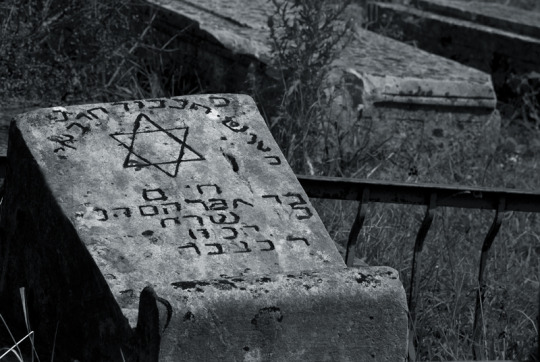

Over the centuries, the traditions and customs of this community also adopted many Georgian habits, most obviously those of the Georgian feasts and church holidays. The impact of Georgian culture is clearly seen in many areas, although equally evident is the similarity of the customs of the Georgian Jewish communities to those of the Jewish communities in Kurdistan, Persia and Turkey, which shows that, despite Georgia’s geopolitical isolation, the Jews always had close ties to their fellow believers living nearby.
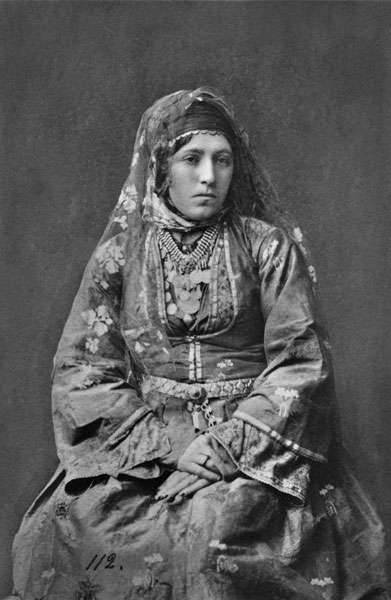
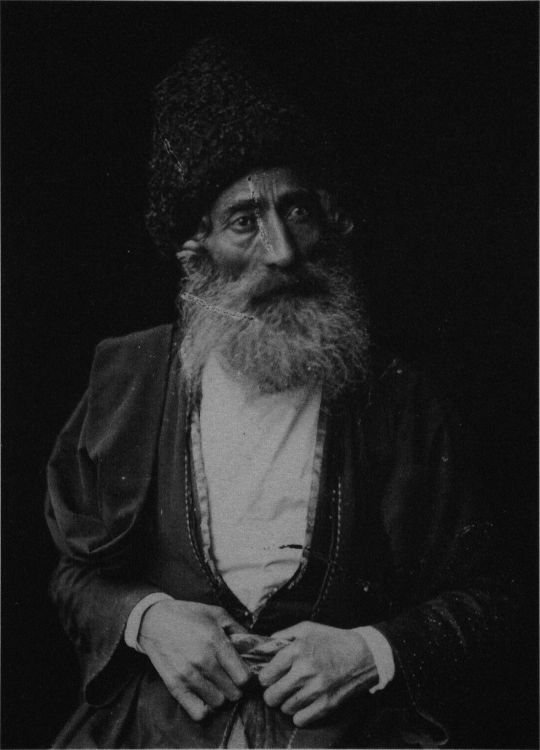
Until the Modern period, most Georgian Jews lived in villages and engaged in agriculture, especially vitaculture. After the abolition of serfdom by the Russian authorities (1864–1871), the Jews moved to towns, settling around the synagogues they founded there, thus initiating a process of establishing communities.


The Red Army invaded Georgia in February 1921, prompting a mass exodus from the region. Approximately 1,500–2,000 Jews left Georgia for Istanbul and Palestine. The Bolshevik government discriminated against the Jewish community, arresting and murdering most of its leaders, scattering Jews forcibly among farms and factories and inciting blood libels up to the 1960s. The only surviving Jewish institution was the History and Ethnography Museum, but it was soon closed down and its director arrested in the early 1950s, thus signifying the annihilation of Jewish culture in Georgia, which the Soviets had built up during the prewar years. But despite their attempts, most Georgian Jews managed to observe their traditions and preserve their identity.
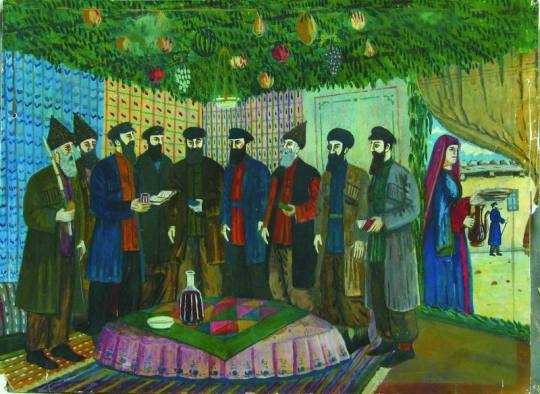

The situation of the Jewish community of Georgia improved dramatically after the fall of the Soviet Union. In 1994, President Shevardnadze issued a decree to protect Jewish religious, cultural and historic monuments. The Georgian Orthodox Church and the Jewish community of Georgia signed a cooperation agreement of mutual respect and support.
Many Georgian Jews now live in Israel. In the United States, the principal Georgian Jewish synagogue is the Congregation of Georgian Jews in the Forest Hills section of Queens, New York City. Georgian Jews are also member of the Antwerp, Moscow, Berlin and Istanbul Jewish communities. Of the 250,000 Georgian Jews today, only around 3,000 live in Georgia proper.


85 notes
·
View notes
Text
Scientists Created a High-Resolution Global Map of Clinically Relevant Antimicrobial Resistance Genes

According to the World Health Organization (WHO), antibiotic resistance is reaching an alarmingly high level worldwide. New resistance mechanisms are unwinding and spreading over the world, posing a threat to our ability to treat common infectious diseases. As antibiotics become less efficient, a rising number of infections are becoming more difficult, if not impossible, to cure.
Researchers from the University of Antwerp screened 17939 assembled metagenomic samples from 21 different biomes, varying in sequencing quality and depth, over 46 countries, across 6 continents, for a period of 14 years (2005-2019) for clinically crucial antibiotic resistance genes (ARGs) commonly found in human biomes, anthropogenic biomes, and natural biomes such as freshwater, marine, and sediment. The study identifies checkpoint biomes in which interventions designed to disrupt clinically relevant mobile ARGs are likely to significantly reduce their dissemination and global burden in the long run.
Continue Reading
#bioinformatics#antibiotic resistance#antimicrobial resistance#mdr#antibiotics#microbiome#infectious diseases#scicomm#stem#medcomm#science news
112 notes
·
View notes
Photo

La Mode illustrée, no. 8, 24 février 1862, Paris. Jeune fille du Brabant et d'Anvers. Costumes anciens et modernes de César Vecellio. Ville de Paris / Bibliothèque Forney
Les jeunes filles d'Anvers portent une coiffure faite d'un voile blanc, fin et de soie, dans lequel elles enroulent les tresses de leurs cheveux, serrés par un cercle d'or qui ressemble à une couronne. Le front et les tempes sont entourés de quelques frisons modestes. Le vêtement, de soie, de velours ou d'autre étoffe, selon la saison, est très-étroit, avec un corsage peu liant et tout uni. Elles ont des épaulettes d'un travail élégant, d'oîi partent des manches gracieuses, attachées dans toute la longueur par des rubans de soie blanche. La taille est ordinairement entourée d'une ceinture qui vient ensuite jusqu'aux pieds. Elles ont une collerette à jolis tuyaux, fermée par des boutons d'or.
Young girl from Brabant and Antwerp.
The young girls of Antwerp wear a headdress made of a fine, white veil of silk, in which they wrap the braids of their hair, held tight by a circle of gold resembling a crown. The forehead and the temples are surrounded by some modest frills. The garment, of silk, velvet, or some other stuff, according to the season, is very narrow, with a bodice loose and plain. They have epaulets of elegant workmanship, from which spring graceful sleeves, fastened along the whole length by ribbons of white silk. The waist is usually surrounded by a belt which then comes to the feet. They have a collar with pretty pipes, fastened with gold buttons.
#la mode illustrée#19th century#1800s#1860s#1862#periodical#fashion#fashion plate#retouch#costume#history#description#masquerade#Forney#Vecellio#dress#Antwerp#Brabant#headdress#ruff#collar#veil
49 notes
·
View notes
Text
Ladies please share to spread the word about two exhibits featuring women artists in two different cities

Artemisia Gentileschi, Self Portrait as Saint Catherine of Alexandria (ca. 1615–17). Collection of the National Gallery, London.
Renaissance art calls to mind some of the greatest names in art history—Da Vinci, Raphael, Michelangelo, and Donatello, just to name a few. Lesser known, however, are the influential women artists who shaped the era.
Referring to a period that bridged the end of the Middle Ages and early Modernism, the Renaissance was marked by a widespread effort to recover and advance the accomplishments of classical antiquity. Originating in Florence, Italy, but soon spreading throughout Europe, Renaissance art saw the advent of advanced linear perspective and an increase in realism. Many women artists—famous in their own time—were among these great visionaries.
Though for centuries, these women artists were largely overlooked in the annals of art history, contemporary scholarship has begun a long overdue reappraisal and rediscovery of their lives and works. Evidence of this resurgence of interest in the women artists of the Renaissance can be seen in the two current major museum shows in the U.S. that are dedicated to just that. “Strong Women in Renaissance Italy” at the Museum of Fine Arts, Boston brings together over 100 works from the 14th through early 17th century, exploring the lives and work of Italian women artists and is on view through January 7, 2024. At the Baltimore Museum of Art, “Making Her Mark: A History of Women Artists in Europe, 1400–1800” is a sweeping exhibition that aims to rectify critical oversight and bring awareness to historical women artists, and is also on view through January 7, 2024,.
In light of these two important exhibitions, we’ve brought together a brief introduction to five Renaissance women artists whom we think you should know.
Plautilla Nelli (1524–1588)

Plautilla Nelli, St. Catherine with Lily (ca. 1550). Collection of Le Gallerie Degli Uffizi, Florence.
Plautilla Nelli was a nun of the Dominican order at the convent of St. Catherine of Siena in Florence—and is considered by many scholars to be the first-known woman artist of Renaissance Italy. A self-taught painter, Nelli led a women’s artist workshop from the convent, and she was one of the few women mentioned in Vasari’s seminal treatise Lives of the Most Excellent Painters, Sculptors, and Architects. Because she developed her practice without formal training and was forbidden from studying male nudes, Nelli frequently copied works by other artists, as well as motifs from religious texts and sculpture.

Nelli’s work recently came into the limelight for her immense painting Last Supper, dating to 1568. Measuring over 21 feet long and 6 feet high, the painting remained in her convent’s refectory until the early 19th century, before being moved to another convent’s refectory and, ultimately, being placed in storage. Following an early 20th-century restoration and several more moves, it went on view to the public for the first time in over four centuries at the Santa Maria Novella Museum in 2019. Hanging alongside other masterworks by artists like Brunelleschi, it finally is getting the widespread recognition it deserves.
Catharina van Hemessen (1528–after 1565)
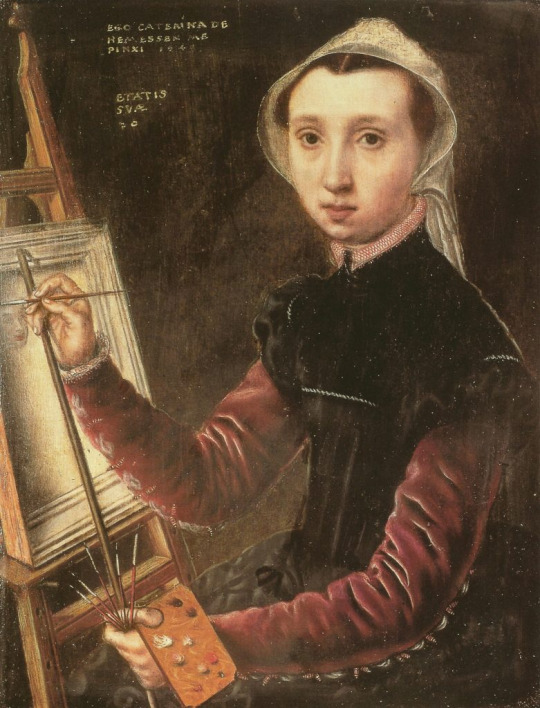
Catharina van Hemessen, Self-Portrait (1548). Collection of Kunstmuseum Basel.
Northern Renaissance painter Catharina van Hemessen was the daughter of prominent Mannerist painter Jan Sanders van Hemessen, and is the earliest Flemish woman painter with verified work that still exists today. Hailing from Antwerp, van Hemessen achieved success in her lifetime, including obtaining the patronage of Maria of Austria, regent of the Low Countries. She was included both in Vasari’s collection of artist biographies, as well as artist biographer Lodovico Guicciardini’s Description of the Low Countries (1567). Van Hemessen’s greatest claim to fame, however, is that she is attributed with completing the first known self-portrait of an artist at their easel—a compositional approach that has become a pillar of the art historical canon, as it has been taken up by artists ranging from Rembrandt van Rijn to Norman Rockwell.
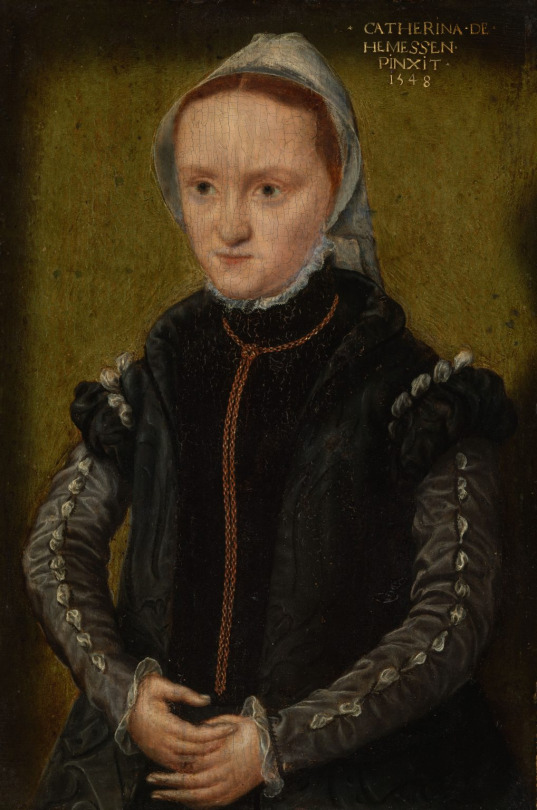
Though she created religious images, she was most well known as a portraitist. Eight portraits and two religious compositions signed by van Hemessen have survived, dating between 1548 and 1552. Notably, there are no verifiable works dating to later than 1554, which have led scholars to believe she ceased painting following her marriage to organist Christian de Morien that year—though there are records she continued to teach three male apprentices.
Sofonisba Anguissola (ca. 1532–1625)
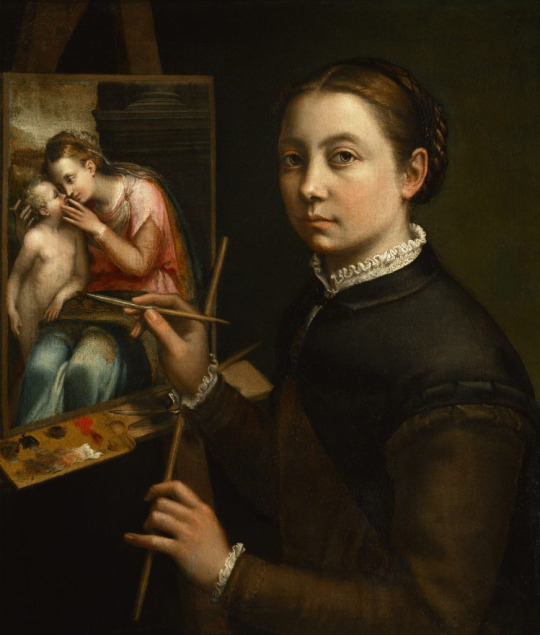
Sofonisba Anguissola, Self-portrait (ca. 1535–1625). Collection of Łańcut Castle Museum, Poland.
Sofonisba Anguissola was one of the most successful women artists of the Renaissance, with a reputation that rose to international acclaim in her lifetime. Born into a noble Milanese family, Anguissola was able to pursue her artistic aspirations with the support of her family, and began her formal training as a teenager; first apprenticing with Bernardino Campi for three years before working with Bernardino Gatti. Her position also allowed for her to become acquainted with Michelangelo, whom she exchanged drawings with. Her early career saw her complete numerous self-portraits as well as portraits of her sisters, including The Game of Chess (1555), which are noted for their realism and liveliness.

Sofonisba Anguissola, The Game of Chess (ca. 1555). Collection of the National Museum in Poznań, Poland.
Anguissola’s reputation as a painter quickly spread, and she was invited to join the court of King Philip II of Spain in Madrid in approximately 1559. Throughout her 14-year tenure there, she completed many official portraits of both members of the royal family and members of the court, adopting the formal and intricate style expected—though unfortunately, no work from this period survived due to a palace fire in the 18th century. Having garnered considerable royal favor, she ultimately spent the remainder of her life continuing to paint as well as teach and engage with young, up-and-coming artists. In 1624, one such young artist by the name of Anthony van Dyck visited Anguissola and recorded his visit in a series of sketches and noted that he learned more about the principles of painting from her than from anything else he had encountered.
Lavinia Fontana (1552–1614)

Lavinia Fontana, Self-portrait at the Spinet with Maid (1577). Collection of the Accademia Nazionale di San Luca, Rome.
Trained by her artist father Prospero Fontana, a teacher at the School of Bologna, Lavinia Fontana is considered the first professional woman artist insofar as she supported herself and her family solely on the income from her commissions. Unconventional for the time, her husband acted as her agent and took a primary role in childcare for their 11 children. She began her commercial practice in her mid-twenties, creating small devotional paintings, but later began and excelled at creating portraits—and became a favorite of Bolognese noblewomen who vied for her services. Unusual for the period, she also created large-scale mythological or religious paintings that occasionally featured female nudes.

Lavinia Fontana, The Visit of the Queen of Sheba to King Solomon (1599). Collection of the National Gallery of Ireland, Dublin.
In the early years of the 17th century, she was invited to Rome at the invitation of Pope Clement VIII and was soon appointed as an official portraitist at the Vatican, counting Pope Paul V as one of her sitters. Her career success continued to thrive, as evidenced by the numerous honors she received, and the bronze portrait medallion cast in her likeness by sculptor and architect Felice Antonio Casoni. She was also one of the first women elected to the Accademia di San Luca in Rome.
Artemisia Gentileschi (1593–1653)
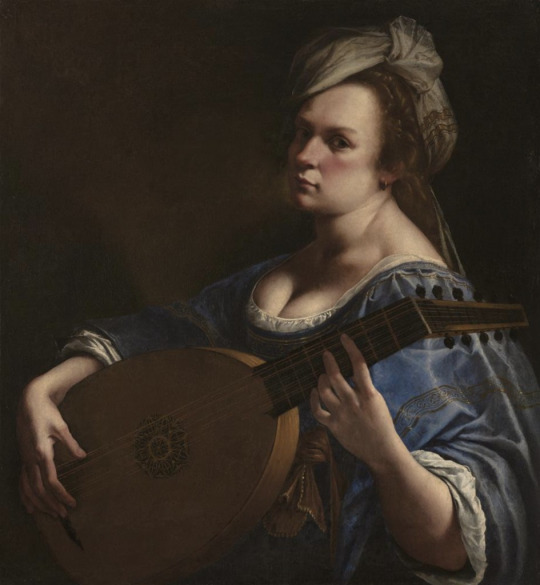
Artemisia Gentileschi, Self-portrait as a Lute Player (ca. 1615–1618). Collection of the Wadsworth Atheneum Museum of Art, Hartford.
Unlike many of her predecessors, Artemisia Gentileschi has maintained a level of renown over the centuries, with her dramatic and dynamic oeuvre that was unprecedented in her own time. Her Baroque compositions helped usher in a new era of painting. Today, her paintings draw the attention of global audiences. Born in Rome, her father was the painter Orazio Gentileschi, who trained Artemisia starting at an early age. Inspired greatly by the work of Caravaggio and his use of high-contrast compositions, her paintings garnered and maintained attention for their naturalism and nuance, as they broke from the idealism of generations past.

Artemisia Gentileschi, Judith and Her Maidservant with the Head of Holofernes (ca. 1623–1625). Collection of the Detroit Institute of Arts.
In 1612, Gentileschi relocated to Florence, which is where she first achieved major career success, including securing patronage from the House of Medici and being the first woman to attend the Accademia delle Arti del Disegno. From her oeuvre, Gentileschi has become most well-known for her self-portraits as well as religious scenes, specifically the story of Judith Beheading Holofernes—of which there are at least six known variations she completed. Gentileschi’s tendency to portray women as the protagonists of her works—and as equals to their male counterparts—made her innovative in her time and has subsequently secured her legacy as one of the most influential artists within Western art history—of either sex.
#Women in Art#Strong Women in Renaissance Italy#Museum of Fine Arts#Boston#There until January 7 2024#Making Her Mark: A History of Women Artists in Europe 1400 -1800#Baltimore Museum of Art#Plautilla Nelli (1524–1588)#Catharina van Hemessen (1528–after 1565)#Catharina van Hemessen created a whole genre in self portraits#Sofonisba Anguissola (ca. 1532–1625)#Lavinia Fontana (1552–1614)#Artemisia Gentileschi (1593–1653)
10 notes
·
View notes
Text
barca vs. shakhtar donetsk match analysis (11/07/23)
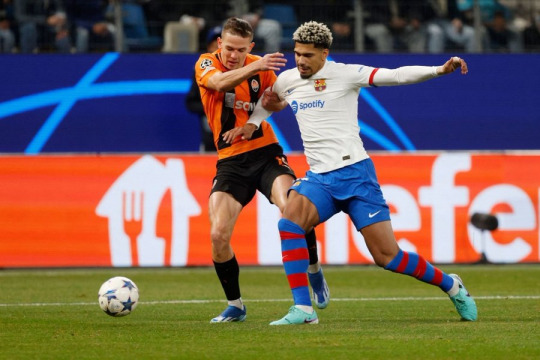
wow, what can i even say. i have to start, i guess, by saying that we are in a really bad moment mentally. i think the clasico loss really took a toll on us. we haven't played as bad as we have in the last two games ever, and i've been watching barcelona since 2011. i've never seen something so anti-barca.
next i have to say i do NOT agree with sacking xavi. it's not the solution, especially not after two bad games. however i do think he is heavily to blame for what happened today. lewandowski should not be playing, period, but i understand we don't really have too many other options. but i'll get to him later, i want to go player by player and start with xavi. tactically we need a change, but the real sociedad game worried me more because we were actually playing our starters and not oriol/alonso.
okay, now to the players. i'll start at the back with ter stegen. despite my strong feelings about him i have to say he had a decent game and the goal wasn't his fault as much as the defense's. it could have been a lot worse without him.
next, christensen. he left the man completely unmarked but other than i didn't think he was really really bad. it was the one mistake that got us. araujo and cancelo were pretty decent and seemed like some of the only two players that were really trying to win. alonso is alonso, and balde played well when he came in.
the midfield was horrible. our build-up is nonexistent. part of this lies in the fact that xavi chose to play gavi higher up the field especially when he was doing so well in that deeper 8 role. he didn't get involved in the game. gundogan tried, to his credit. pedri did what he could when he came in and so did fermin. romeu i won't discuss, he's not my issue. there just needs to be so much more cohesion.
now for the elephant in the room. the attack. what can i say about them that isn't mean. lewandowski, ferran, and raphinha produced nothing today. 1 shot on target for an attack of this caliber is just pathetic. we need a real forward immediately, roque can't come soon enough. jesus.
anyway, overall this isn't how this team usually plays, i don't know what this was. i don't want to see us in the uel again, but if we play like this that's where we're going. all we need is one more point, and this was our best chance to do that. now we have to play porto, a much harder opponent, and i don't want to leave off qualifying until antwerp.
yeah. there are some tactical things that need to be fixed, but another issue is the lack of a good #9. lewy is just too old. also, there are basic things we can't do like heading, weighing passes, and just working together. no reason for professional footballers to do that. our players aren't given enough of the blame for what happens in games.
15 notes
·
View notes
Text



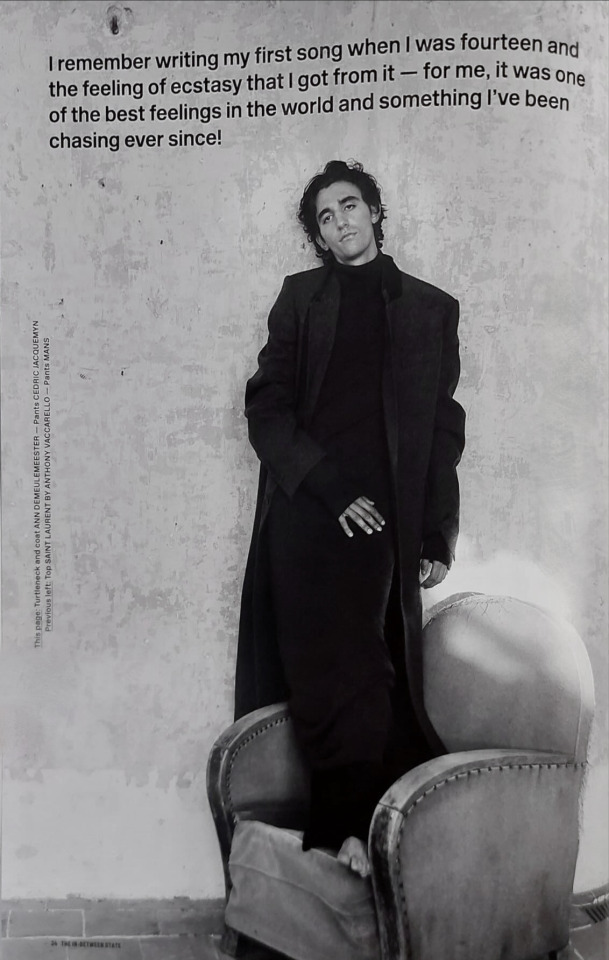






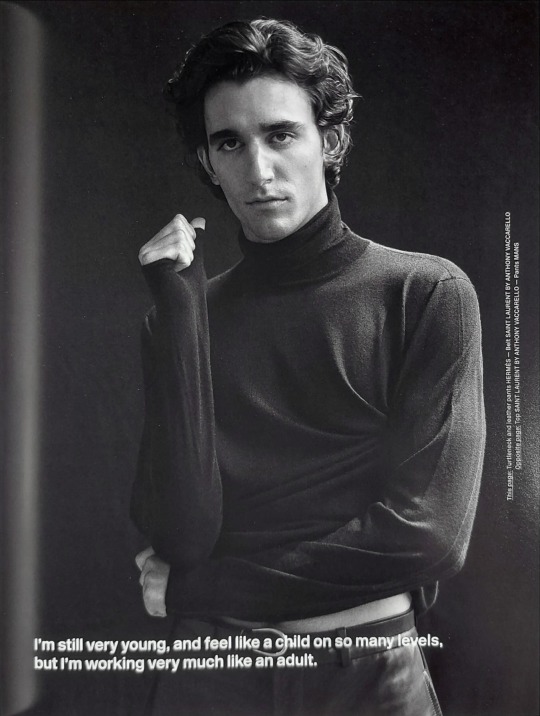

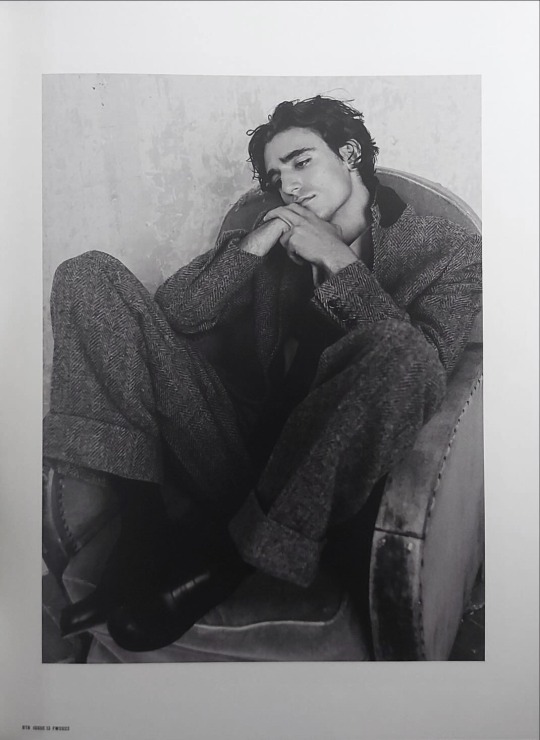

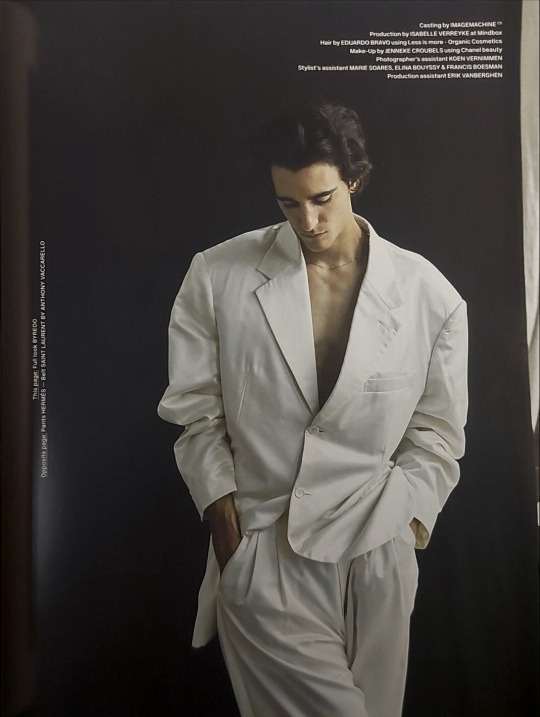
— Tamino for Behind The Blinds, Issue 13 / Fall/Winter 2022 (x)
Tamino: The In-Between State
Antwerp, July 2022
Interview by
MARTIN ONUFROWICZ
Photography by
ZEB DAEMEN
Fashion by
JONATHAN HUGUET
For Tamino, the title of his new album, Sahar, reflects his mindset while working on the record. “The literal meaning of the word is “just before dawn” and I think that perfectly captures the feeling of being in this in-between realm that I felt at the time,” explains the Belgian-Egyptian singer. Having catapulted him to fame in Belgium just after turning 20, Tamino’s debut album Amir also earned him fans from all over the globe, leading to non-stop touring for years. With instant popularity — and responsibility — at a young age, Tamino oscillates between adolescence and adulthood; this very in-between state being at the core of his latest record.
With Sahar, the musician continues to express the melancholy and vulnerability that became a signature of his artistic language. The key tool in creating the record was the Arabic lute known as the oud — an instrument that takes center stage in a ballad titled A Drop of Blood. “With this song, I wanted to accompany myself with the oud as the main instrument, just like my grandfather and father did in the past,” says Tamino. “It was very important for me to have at least one song like this on the album to honor the traditions of Egyptian and Arabic music.”
MARTIN ONUFROWICZ: Why did you decide to name your new album Sahar? What is the meaning that this title holds to you?
TAMINO: The literal meaning of the word Sahar is ‘just before dawn’ and I think that perfectly captures the feeling of being in this in-between realm that I felt at the time of creating the album, and still feel a bit right now.
MO: Where is this feeling of being in an in-between state coming from?
TAM: It has a lot to do with what my life has looked like in the last couple of years. I went from moving to Amsterdam to study, where I felt so out of place, to moving back to Belgium and my music career taking off, and starting to tour almost immediately for years. It felt a bit like tunnel vision — my life started to just revolve around one thing. I’m still very young, and feel like a child on so many levels, but I'm working very much like an adult.
MO: The album was written during the solitary times of the pandemic. How has that period affected you?
TAM: I was always planning on having a break because my team saw that I was feeling a bit burned out. So when it came a bit earlier than expected, I was quite happy about it. That said, I always imagined that when I will have my rest, I will be able to integrate into the world again as a regular person who's not traveling all the time, but then that wasn't the case either because everyone was at home, and life as we knew it was on hold. I think that period has definitely contributed to that feeling of in-betweenness as well, and was also a very transformative and important time for me personally.
MO: You're starting touring again later this year. Having this perspective now, how are you going to try to avoid the burnout you had a couple of years ago?
TAM: That was the one thing I kept saying to myself during the break, “I’m going to learn from this and take this zen feeling that I found into the busy life that awaits me again." Of course, I’m not sure how well I will do, but it definitely already affected how I approach work. For example, I’m now in New York for a couple of weeks and not just packing all the promotion stuff into one week because I thought, "I don't really have that much to do in July, so let me spend some time here and see what it’s like." I wanted to be here long enough to be able to ground myself, get to know some new people, have fun and be inspired.
MO: That sounds like a really good idea! What are your favorite places in the city so far?
TAM: I’m staying in Williamsburg, which I really like. I also really enjoy the Lower East Side. I went to Central Park yesterday, which is always amazing. But I have yet to discover a bar or a restaurant that I really love — I’ll know when it will happen because I’m a creature of habit, so when I find it, I will want to return there every day. [Laughs.]
MO: Which of the songs on the album was the easiest to write and which one was the most challenging?
TAM: The one that I wrote really fast was The Longing, the first song on the album. I first came up with the guitar-picking sound that I recorded on my phone and the next day while being in bed, I listened back to the recording and started humming the melody. Then, all of the verses came in one go! I was stunned because that rarely happens, so that was a very cool moment. A Drop of Blood was probably the song that was the biggest challenge for me because it was the one that I knew I wanted to write — all the other ones were improvised while I was trying out sounds with the guitar. With this song, I knew that I wanted to accompany myself with the oud as the main instrument, just like my grandfather and father did in the past. It was very important for me to have at least one song like this on the album [to honor] the traditions of Egyptian and [more broadly] Arabic music.
MO: Looking back, do you remember having a clear moment when you realized that music was something that you wanted to pursue as a career?
TAM: Music was always something I did, but I never really thought about making a career out of it — I remember that while I was growing up, I never really worried about how l am going to make money later and I'm very thankful for that to my mom. We didn’t have a lot growing up — she was a single mom with three kids — but she never put pressure on us to earn a lot or anything like that. I do remember clearly writing my first song when I was fourteen and the feeling of ecstasy that I got from it — for me, it was one of the best feelings in the world and something I've been chasing ever since!
MO: What's a music album that changed your life?
TAM: There’s been so many, but one that comes to mind immediately is one by Radiohead that I got when I was also around fourteen. I don’t think it was even a specific album, but rather The Best of Radiohead — I just remember being so inspired by their music when I first heard it. Now, my favorite record of theirs is In Rainbows.
MO: That's so cool! It must be a totally dream-come-true situation then for you to now be able to work with Colin Greenwood [one of Radiohead's band members] — I saw that you collaborated with him for Sahar.
TAM: Yeah, it's amazing! It sometimes still feels so surreal when I think about it, but now, Colin has really become a friend to me — we have played a lot of concerts together and he did seven songs with me on the new record. He's a lovely person and it’s a dream to work with a musician of his caliber.
MO: How did you guys first meet?
TAM: We had mutual friends in Antwerp — they took him to one of my shows and that’s how it started.
MO: Let’s end with a throwback question: who was the first musician you saw playing live and what impact did that make on you?
TAM: It was Lenny Kravitz at Sportpaleis in Antwerp. Also, his song I’ll Be Waiting was the first song I deliberately learned by heart — I performed it at a school concert. I love Lenny, he's such a good performer!
#tamino#tamino amir#behind the blinds#article#interview#english#2022#with photoshoot#original text#Huge thanks to taminodaily on twt and an anonymous source for sharing these photos!! :D#i can be at peace now#edit: HUGEE THANK YOU to zita @maneskinglows on twt for sending in these updated photos!!! theyre a bit clearer than the prev ones :))#also i was going to edit out the glare for all the photos but im sorry i cannot bear it anymore i had to edit out their thumb#and if i have to do any more cutting and pasting and warping and shifting and colour matching i'm going to lose my Mind#as it is i used the smudge tool to edit out the glare just dont look too closely thank you 🫶#maybe one day i'll come back to this and be more professional about it but umm until then
58 notes
·
View notes
Text
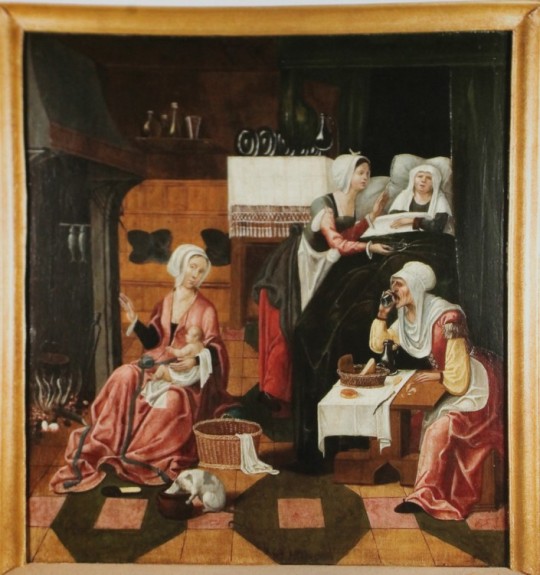
Adriaen van Overbeke - Birth of the Virgin - Petrikirche altarpiece -
Adriaen van Overbeke, Adrian van Overbeck and Adriaen van Overbeke (fl 1508 – 1529) was a Flemish Renaissance painter in the style of Antwerp Mannerism. He operated a large workshop with an important output of altarpieces, which were mainly exported to Northern France, the Rhineland and Westphalia. His known works were predominantly polychromed wooden altarpieces with painted shutters, which were created through a collaboration between painters and sculptors.
Dutch and Flemish Renaissance painting represents the 16th-century response to Italian Renaissance art in the Low Countries, as well as many continuities with the preceding Early Netherlandish painting. The period spans from the Antwerp Mannerists and Hieronymus Bosch at the start of the 16th century to the late Northern Mannerists such as Hendrik Goltzius and Joachim Wtewael at the end. Artists drew on both the recent innovations of Italian painting and the local traditions of the Early Netherlandish artists.
Antwerp was the most important artistic centre in the region. Many artists worked for European courts, including Bosch, whose fantastic painted images left a long legacy. Jan Mabuse, Maarten van Heemskerck and Frans Floris were all instrumental in adopting Italian models and incorporating them into their own artistic language. Pieter Brueghel the Elder, with Bosch the only artist from the period to remain widely familiar, may seem atypical, but in fact his many innovations drew on the fertile artistic scene in Antwerp.
Dutch and Flemish painters were also instrumental in establishing new subjects such as landscape painting and genre painting. Joachim Patinir, for example, played an important role in developing landscape painting, inventing the compositional type of the world landscape, which was perfected by Pieter Bruegel the Elder who, followed by Pieter Aertsen, also helped popularise genre painting. From the mid-century Pieter Aertsen, later followed by his nephew Joachim Beuckelaer, established a type of "monumental still life" featuring large spreads of food with genre figures, and in the background small religious of moral scenes. Like the world landscapes, these represented a typically "Mannerist inversion" of the normal decorum of the hierarchy of genres, giving the "lower" subject matter more space than the "higher". Anthonis Mor was the leading portraitist of the mid-century, in demand in courts all over Europe for his reliable portraits in a style that combined Netherlandish precision with the lessons of Titian and other Italian painters.
10 notes
·
View notes